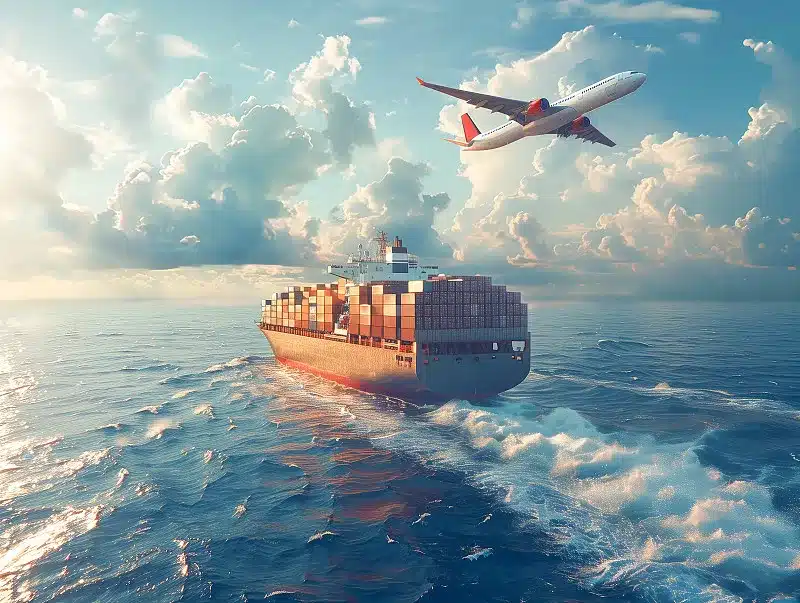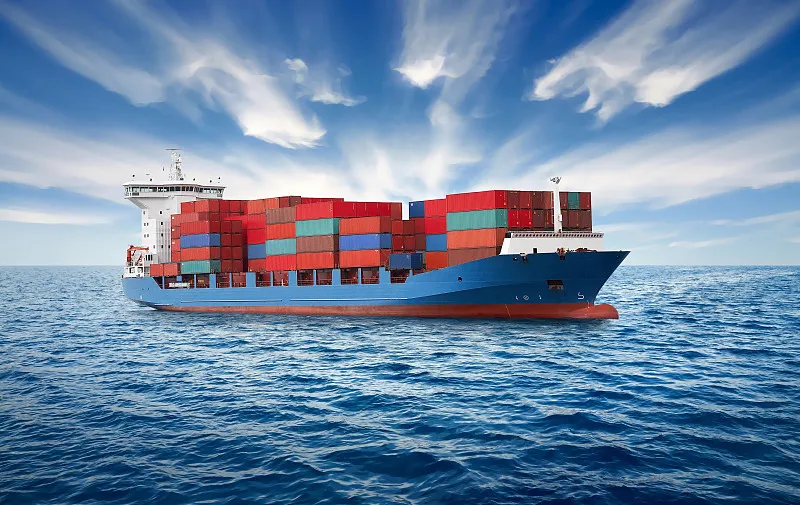China has long been one of Iran’s key trading partners. Despite ongoing U.S. sanctions, China remains a vital export destination for Iranian crude oil, mineral resources, and industrial goods while also serving as a major supplier of machinery, electronics, auto parts, and light industrial products to Iran. As trade between the two countries continues, understanding how to navigate freight shipping from China to Iran is essential for businesses. This guide offers insight into container shipping costs and their breakdown to help you plan your logistics more effectively.

Container Options for Shipping from China to Iran
Depending on your cargo size and budget, you can choose from the following container shipping options:
- Full Container Load (FCL): You rent an entire container exclusively for your shipment. This option is cost-effective for large volumes that can fill or nearly fill the container, offering greater security and faster transit times with fewer handling steps.
- Less than Container Load (LCL): Your goods share container space with shipments from other exporters. This is ideal for smaller volumes, as you only pay for the space you use. While it’s more economical for low-volume cargo, LCL may involve slightly longer transit times due to the consolidation and deconsolidation.
The most common standard dry container types include:
- 20ft container: has an internal capacity of about 28 – 30 cubic meters.
- 40ft container: has an internal capacity of about 58 – 60 cubic meters.
- 40HQ: This container is about 1 foot taller than a 40ft and holds around 68 – 70 cubic meters, making it ideal for bulky but lightweight goods.
| Container Type | External Dimensions (L×W×H) | Internal Dimensions (L×W×H) | Volume | Max Payload | Tare Weight |
|---|---|---|---|---|---|
| 20GP | 6.06 m × 2.44 m × 2.59 m | 5.90 m × 2.35 m × 2.39 m | 28-30 m³ | 24,000 kg | 2,300 kg |
| 40GP | 12.19 m × 2.44 m × 2.59 m | 12.03 m × 2.35 m × 2.39 m | 58-60m³ | 30,480 kg | 3,700 kg |
| 40HQ | 12.19 m × 2.44 m × 2.89 m | 12.03 m × 2.35 m × 2.69 m | 68-70 m³ | 30,480 kg | 4,100 kg |
- Other special container types include reefers (refrigerated containers) for transporting goods that require temperature control, open-top containers for extremely high goods, and flat rack containers for oversized or heavy goods.
Related content:
How many containers can a container ship carry at most?
How many pallets can fit in a Container?
MSC Container Tracking System: Ultimate Guide
Types and sizes of common sea containers
Cost of Shipping 20ft and 40ft Containers from China to Iran
These are the average prices to ship a container from China to Iranwith the cheapest rates for loading and shipping containers from the major ports in China to Nigeria for 20ft and 40ft containers (FCL) with all types of cargo, such as commercial cargo, vehicles, or personal effects for international shipments from China to Iran.
| Origin (China) | Destination (Iran) | 20ft Container Cost | 40ft Container Cost |
|---|---|---|---|
| Shanghai | Bandar Abbas | $1,800 – $3,500 | $2,500 – $4,100 |
| Shanghai | Bushehr | $1,750 – $3,550 | $2,350 – $4,250 |
| Shanghai | Bandar Imam Khomeini | $1,650 – $3,250 | $2,450 – $4,050 |
| Shenzhen | Bandar Abbas | $1,500 – $3,000 | $2,100 – $3,600 |
| Shenzhen | Bushehr | $1,650 – $3,350 | $2,150 – $3,850 |
| Shenzhen | Bandar Imam Khomeini | $1,550 – $3,250 | $2,150 – $3,750 |
| Ningbo | Bandar Abbas | $1,700 – $3,200 | $2,700 – $4,500 |
| Ningbo | Bushehr | $1,650 – $3,350 | $2,650 – $4,550 |
| Ningbo | Bandar Imam Khomeini | $1,750 – $3,250 | $2,850 – $4,550 |
If you want to know the shipping cost to other countries you can read:
Cost of Shipping 20ft & 40ft Containers from China to Egypt
Cost of Shipping 20ft and 40ft Containers from China to Kenya
Cost of Shipping 20ft and 40ft Containers from China to USA
Cost of Shipping 20ft and 40ft Containers from China to Canada
Choosing Between 20ft and 40ft Containers
When choosing between a 20ft container and a 40ft container, you need to consider several factors, such as the volume and weight of your goods, the cost of shipping, and the shipping route.
20ft containers are ideal for smaller loads and can handle about half the volume and weight of a 40ft container. These containers are the more cost-effective option for lighter, less voluminous goods, and are easier to handle and load, making them a popular choice for many businesses.
On the other hand, 40ft containers can accommodate larger, heavier loads, making them suitable for businesses with high-volume shipping needs. Although they cost more to transport, they are generally more economical for large-volume shipments, as you’re essentially getting twice the space for less than twice the price of a 20ft container.

Step-by-Step Guide for Shipping a Container from China to Iran
1. Find the best freight forwarder
First, choose a reliable and trustworthy freight forwarder with services covering China and Iran.
You can choose to work with us. Hongocean has extensive experience in China-Iran shipping services. We are committed to providing professional services as a freight forwarding company specializing in helping small and medium-sized enterprises and e-commerce businesses transport goods efficiently and cost-effectively.
2. Select the best carrier
Contact us to obtain the latest shipping rates from China to Iran and select the most suitable carrier based on your budget and cargo volume.
3. Pick up or transport goods from the supplier
Arrange for us to pick up the goods from the factory or supplier and transport them to the designated departure port.
4. Prepare the necessary documents
Prepare complete and accurate shipping documents, including those required by Chinese export customs and Iranian import customs.
- Packing list
- Certificate of Origin
- Bill of Lading (or Air Waybill)
- Commercial Invoice
You will need an Iranian import cargo manifest, which the carrier must complete.
5. Calculate Tariffs and Taxes
Determine the tariffs and taxes required for import into Iran based on the correct tariff rates and HS codes.
6. Include Additional Taxes
Check if your goods are subject to additional taxes. For example, if transporting tobacco products or alcoholic beverages, consumption taxes may apply.
7. Clear customs in Iran
Pay all applicable duties, fees, and taxes to allow customs to release the goods.
8. Arrange final delivery
Plan to transport the cleared goods to the final destination, which may be the consignee’s designated address, business premises, or preferred warehouse.
Although these steps may seem straightforward, the process can be quite complex.
In some cases, you may need to hire a customs broker.
As mentioned, collaborating with a freight forwarder can simplify transportation and customs clearance. At Hongocean, we handle transportation coordination and act as customs brokers to help expedite the clearance process.
Prohibited & Restricted Items for Shipping from China to Iarn
The Customs Tariff Schedule, specific national laws, and the policies of various regulatory bodies govern import regulations in Iran. Below is a summary of items that are generally prohibited from entering the country:
- Legally Restricted Goods: Any items banned under the Customs Tariff Schedule or specific Iranian laws.
- Weapons and Explosives: This includes firearms, hunting rifles, ammunition, shells, explosives, and any flammable or explosive substances unless explicitly authorized by the Ministry of Defense and the Armed Forces Logistics Department.
- Narcotics: The import of drugs is strictly prohibited unless approved by the Ministry of Health, Medical Education, and Research.
- Aerial Photography Equipment: Specialized drone or aerial videography equipment may not be imported without prior approval from the Ministry of Defense and the Armed Forces Logistics Department.
- Communication Devices: Transmitters and related components require the Ministry of Posts and Telecommunications authorization.
- Culturally Sensitive Media: Records, tapes, films, and books considered to disrupt public order, damage Iran’s national image, or violate religious customs are banned, as determined by the Ministry of Culture and Islamic Guidance.
- Publications and Symbols: Magazines, newspapers, imagery, or any symbols judged by Iranian intelligence agencies to be offensive or destabilizing are not permitted.
- Packaging and Labeling Violations: Items with packaging, delivery documents, or markings that include offensive language, misleading manufacturer claims, or culturally inappropriate content are prohibited.
- Counterfeit Currency and Banknotes: This includes counterfeit money, decommissioned foreign currency, invalid stamps, or imitation monetary tokens.
- Lottery Tickets: The importation of lottery tickets is not allowed.
- Misleading Branding: Products whose labeling may confuse consumers about the goods’ true origin, manufacturer, or features are not allowed.
- Restricted Food and Agricultural Products: Iran may ban or limit imports of certain agricultural items based on domestic supply levels. For example, palm oil has faced past restrictions, while some tropical fruits are allowed.
Recommendations for Shipping from China to Iran
To ensure smooth, compliant, and efficient shipping operations between China and Iran, consider the following best practices:
1. Partner with an Experienced Freight Forwarder
Choose a freight forwarder with proven experience handling China–Iran trade routes. Ideally, they should be well-versed in both countries’ customs regulations and up to date on international sanctions and compliance issues.
2. Consult Customs Authorities
Stay informed by contacting the Chinese and Iranian Customs offices for the most current information on import/export rules, documentation requirements, and lists of restricted or prohibited items.
3. Seek Legal and Compliance Guidance
For sensitive or high-risk goods or dealing with complex trade transactions, it’s wise to engage legal and compliance experts. They can help ensure your shipment aligns with all applicable laws, trade agreements, and sanction regulations—minimizing the risk of penalties or shipment delays.

Tips for Reducing Shipping Costs from China to Iran
- Plan in Advance: Secure your shipping space early—especially before peak seasons like holidays—to lock in better rates and avoid last-minute availability issues.
- Compare Multiple Quotes: Contact several freight forwarders or shipping lines. Comparing costs, transit times, and service offerings can help you identify the most competitive option.
- Choose the Right Shipping Mode and Container Type: Select between FCL (Full Container Load) and LCL (Less than Container Load) based on the size and volume of your cargo. Use appropriately sized containers to avoid underutilized space or overpacking.
- Optimize Your Packaging: Efficient packaging reduces wasted space and lowers LCL costs, which are typically charged based on volume. Well-packaged goods also minimize damage risk.
- Consider Alternative Ports: Sometimes, a slightly farther port with lower fees can lead to overall savings—even after factoring in inland transportation costs. Be sure to calculate the total door-to-door expense.
- Be Flexible with Schedules and Carriers: If delivery time is not critical, consider indirect or transshipment routes. These options often come with lower rates than express or direct services.
- Understand and Leverage Incoterms: Use international trade terms like FOB, CIF, or EXW wisely to define cost responsibilities clearly and avoid unexpected charges.
- Build Strong Freight Forwarder Relationships: Reliable forwarders often offer better service and may provide preferential pricing or support to long-term partners.
- Track Market Trends: Monitor global shipping rate trends. Planning shipments when rates dip—such as during off-peak seasons—can lead to significant savings.



